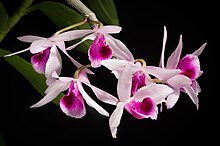| Unscented Dendrobium | |
|---|---|

| |
| Conservation status | |
| CITES Appendix II (CITES) | |
| Scientific classification | |
| Kingdom: | Plantae |
| Clade: | Tracheophytes |
| Clade: | Angiosperms |
| Clade: | Monocots |
| Order: | Asparagales |
| Family: | Orchidaceae |
| Subfamily: | Epidendroideae |
| Genus: | Dendrobium |
| Species: | D. anosmum |
| Binomial name | |
| Dendrobium anosmum Lindl. (1845) | |
| Synonyms | |
| |
Dendrobium anosmum, commonly known as the unscented dendrobium, is a species of epiphytic orchid with large purple flowers. It is widespread across Southeast Asia from Sri Lanka to New Guinea, including Indochina, Indonesia, the Philippines, etc. Despite its common name and scientific name, D. anosmum usually has a strong fragrance reminiscent of raspberries.
The species was first described by the English botanist John Lindley from specimens collected in the Philippines. The first varieties he discovered were scented, which he named Dendrobium macrophyllum in 1839. Six years later in 1845, he acquired unscented specimens which he named Dendrobium anosmum in reference to their perceived lack of smell. However, they have since been determined to be the same species. The newer name is used because the older name given by Lindley is invalid given that it is a homonym of the pastor's orchid (Dendrobium macrophyllum), which was described earlier in 1834 by the French botanist Achille Richard.
In the Philippines, it is locally known as sanggumay, a Tagalog portmanteau of masangsang (overpowering scent) and nakakaumay (tiresome), referring to its overpowering smell. Another local Filipino name is latigo (horsewhip), referring to its long pendulous canes which became deciduous before flowering. It is one of the most commonly cultivated species of orchids in the Philippines. In Hawaii, the species is known as hono-hono. It is also sometimes known in English as purple rain.
References
- "Appendices I, II and III". Convention on International Trade in Endangered Species of Wild Flora and Fauna. 2010-10-14. Retrieved 2019-12-20.
- ^ Kew World Checklist of Selected Plant Families
- Teoh, Eng-Soon (2005). Orchids of Asia. Marshall Cavendish. p. 120. ISBN 9789812610157.
- Stuart, Godofredo U., Jr. "Sanggumay". Philippine Medicinal Plants. StuartXChange. Retrieved 10 April 2024.
{{cite web}}: CS1 maint: multiple names: authors list (link)
External links
- Dendrobium Superbum (Photos).
 Media related to Dendrobium anosmum at Wikimedia Commons
Media related to Dendrobium anosmum at Wikimedia Commons Data related to Dendrobium anosmum at Wikispecies
Data related to Dendrobium anosmum at Wikispecies
This Dendrobium-related article is a stub. You can help Misplaced Pages by expanding it. |